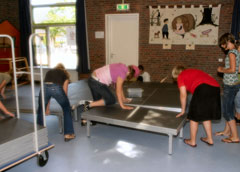Feb 20 2008
Stage builders know only too well that transporting and assembling heavy stage sections can quickly become a pain – quite literally. Yet back complaints resulting from heavy lifting could soon be a thing of the past as the Dutch company Triple-E Lichtgewicht Meubilair B.V. in Winsum is now offering lightweight stage sections under the name “Flax-Deck” with external dimensions of 0.75 by 1.50 meters and a weight of only 16.5 kilograms. The low weight of the stackable and compact sections is due to a sandwich structure based on the Baypreg® polyurethane spray system from Bayer MaterialScience.
 Lightweight stage sections from Triple-E with external dimensions of 0.75 by 1.50 meters weigh only 16.5 kilograms. The low weight of the stackable and compact sections is due to a sandwich structure based on the Baypreg polyurethane spray system from Bayer MaterialScience.
Lightweight stage sections from Triple-E with external dimensions of 0.75 by 1.50 meters weigh only 16.5 kilograms. The low weight of the stackable and compact sections is due to a sandwich structure based on the Baypreg polyurethane spray system from Bayer MaterialScience.
Composite sandwich materials are generally lightweight and extremely stiff. The highly versatile stage sections consist of a light rigid foam core reinforced top and bottom with flax mats to absorb tensile forces, thereby increasing the strength of the composite. The sandwich structure can withstand a concentrated load of up to 150 kilograms. Its surface is protected by a highly abrasion-resistant and robust plastic layer that is available in various colors. Foldaway and height-adjustable aluminum legs are mounted underneath, enabling the sections to be easily set up and assembled.
During production, the fiber mats made out of natural flax are first impregnated on both sides with the dual-component polyurethane system using a spray process. The mats and the expanded polystyrene (EPS) core are then put together to form a sandwich and inserted into a preheated mold. The layered structure is pressed into the desired shape at temperatures normally ranging from 60 to 120 oC and pressures between 6 and 8 bar and cures within a matter of minutes. Post-treatment of the sandwich composite by annealing, for example, is not necessary. This highly economical, one-step production process creates a permanently stable, extremely robust and rigid structure capable of withstanding high mechanical loads. This is due in no small measure to the polyurethane system’s excellent adhesion to various materials.
This application is a further example of the close and successful collaboration between BaySystems® and its customers. As an umbrella brand for Bayer MaterialScience’s global polyurethane systems business, BaySystems® offers a customer-focused, tailor-made service backed by extensive know-how in the worldwide polyurethane systems house network through which Bayer MaterialScience provides its customers with made-to-measure solutions.
Compression molding opens up yet more design options for sandwich technology using Baypreg®. Curves and changes in wall thickness are also possible, for example. This feature was used here to create recesses on the bottom of the stage sections into which the folded-up aluminum legs can be stowed. The sections can thus be stacked on top of one another in a minimum of space when not in use, without damaging their surfaces.